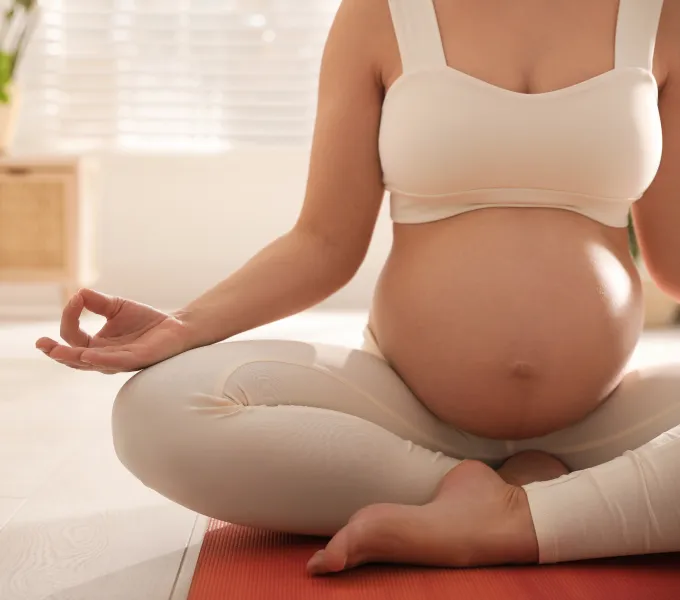
Swollen Feet During Pregnancy: Why It Happens & What To Do
If you’re like most pregnant women, there comes a time when your bump gets so big, you can’t see your own feet. And, as luck would have it, you may not want to see them — because they’re so swollen, they look more like potatoes than the extremities you used to pamper with pedicures.
This uncomfortable swelling of the legs and feet is called edema and occurs in 80% of pregnancies. We asked our friends at Comrad, the makers of socks that help improve circulation and reduce pressure on your veins, to share what they know about the potato feet phenomenon and what you can do to avoid it. Check out their insight and advice below.
How much swelling are we talking about?
First of all, it's important to understand how much feet typically swell during pregnancy. In one study, researchers calculated the volume of women’s feet at regular intervals. They found that, over the course of pregnancy, volume increased an average of 8.5% in each foot. They also discovered that this swelling lasted long into the postpartum period.
Another study found that women demonstrated an increase in foot length, width, and surface area between the 20th to 38th week of pregnancy. During the same time period, the arch of the foot fell by an average of over 24%. So, if you feel like your feet have been getting larger during pregnancy and need more support, there’s scientific evidence to back you up.
Why do feet swell during pregnancy?
The most common cause of swollen feet during pregnancy is chronic venous insufficiency, which occurs when blood can’t adequately flow from the veins in your legs back to your heart, so pools in your calves and feet. This reduction in vein function is due to pregnancy-related hormonal changes, plus the pressure of your growing uterus on a large, central vein called the vena cava.
It’s important to know that there are also serious conditions associated with swelling of the feet and legs, including deep vein thrombosis and preeclampsia. If you notice that your feet are feeling or looking bloated, be sure to tell your healthcare provider. And if you ever experience swelling alongside other symptoms, such as difficulty breathing or chest pain, get medical care right away.
No matter the cause, swollen feet can be uncomfortable. By the time women reach the third trimester of pregnancy, they're often searching for ways to reduce fluid retention and improve venous return. Luckily, you can get relief.
What you can do to manage swelling
Wearing compression socks or stockings is one of the first-line treatments for swollen legs and feet during pregnancy. Studies show that graduated compression hosiery improves venous emptying and reduces subjective reports of discomfort and pain.
There are even more benefits of compression: According to research, it can lead to a measurable improvement in maternal and fetal circulation. England's National Health Service advises pregnant women that wearing prescribed compression stockings can promote circulation in the legs and help reduce the risk of deep vein thrombosis.
To get specific, experts recommend ‘medical compression therapy’ for the duration of pregnancy and for 6 weeks after birth, using a compression strength of 15-20 mmHg for the prevention of edema and 20-30 mmHg for the treatment of edema.
Aside from wearing compression socks, there are other steps you can take to reduce and get relief from swelling in your lower-legs and feet:
- When you can, sit with your feet up or lie down with your legs slightly elevated on pillows.
- With your feet up, rotate your ankles and flex your feet.
- Keep moving in low-impact ways (walks, stationary bike).
- Swim, float, or stand in a pool, as water pressure may give some relief.
- Wear loose-fitting clothing (tight clothes restrict blood flow).
- Get a foot massage or reflexology treatment.
- Drink plenty of water.
Thinking you need some compression socks? At Comrad, we make surprisingly cute options that offer the recommended 15-25 mmHg of compression for pregnancy. You can also read more here about how we’ve designed our socks to make pregnancy a bit more comfortable.
Sources:
- Alvarez, R. et al. “Dimensional changes of the feet in pregnancy.” The Journal of bone and joint surgery, vol. 70, iss. 2, 1988, pp. 271-274, http://www.metodogerar.com.br/wp-content/uploads/2009/11/changes-in-feet-3.pdf.
- Chiou, Wen-Ko, et al. "The influence of body mass on foot dimensions during pregnancy." Applied Ergonomics, Vol. 46, Part A, 2015, pp. 212-217, https://doi.org/10.1016/j.apergo.2014.08.004.
- Cornu-Thenard, André and Pierre Boivin. "Chronic venous disease during pregnancy," Phlebolymphology, vol. 21, iss. 3, 2014, pp. 138-148, https://www.phlebolymphology.org/chronic-venous-disease-during-pregnancy.
- "Deep vein thrombosis in pregnancy." NHS, National Health Service England, 2021, https://www.nhs.uk/pregnancy/related-conditions/complications/deep-vein-thrombosis.
- "Edema." Mayo Clinic, Mayo Foundation for Medical Education and Research (MFMER), 2020, https://www.mayoclinic.org/diseases-conditions/edema/diagnosis-treatment/drc-20366532.
- Nilsson L, et al. "Venous function during late pregnancy, the effect of elastic compression hosiery," VASA, vol. 21, iss. 2, 1992, pp. 203-205, https://europepmc.org/article/med/1621443.
- "Preeclampsia," Mayo Clinic, Mayo Foundation for Medical Education and Research (MFMER), 2020, https://www.mayoclinic.org/diseases-conditions/edema/diagnosis-treatment/drc-20366532.
- Tobah, Y. B. "What causes ankle swelling during pregnancy — and what can I do about it?" Mayo Clinic, Mayo Foundation for Medical Education and Research (MFMER), 2020, https://www.mayoclinic.org/healthy-lifestyle/pregnancy-week-by-week/expert-answers/swelling-during-pregnancy/faq-20058467.
- "Venous Thromboembolism (Blood Clots) and Pregnancy." Centers for Disease Control and Prevention, U.S. Department of Health & Human Services, 2020, https://www.cdc.gov/ncbddd/dvt/pregnancy.html.
- Weber S., et al. "Effects of compression stockings on blood circulation in late pregnancy," Geburtshilfe und Frauenheilkunde, vol. 47, iss. 6, 1987, pp. 395-400, https://europepmc.org/article/med/3623042.
- Yanagisawa, Nami et al. “A Quantitative Method to Measure Skin Thickness in Leg Edema in Pregnant Women Using B-Scan Portable Ultrasonography: A Comparison Between Obese and Non-Obese Women.” Medical science monitor : international medical journal of experimental and clinical research, vol. 25, pp. 1-9, 2019, www.doi.org/10.12659/MSM.911799Yanagisawa.



